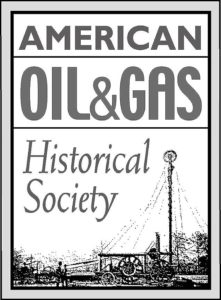by Bruce Wells | Mar 1, 2025 | Energy Education Resources
Oklahoma museum opened in 2011 to preserve history of Sooners and the American West.
The Cherokee Strip Regional Heritage Center (CSRHC) in Enid, Oklahoma, preserves the history of the settling the Cherokee Strip — and the search for petroleum in northwestern Oklahoma. The museum opened in 2011 following six years of work by many Enid residents, including a leading independent producer.
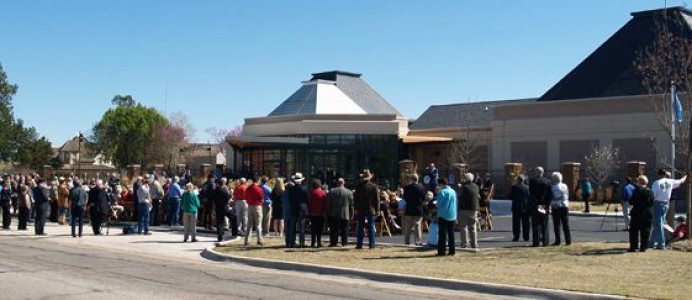
Hundreds gathered for the April 1, 2011, opening of the $10 million Cherokee Strip Regional Heritage Center on the east side of Enid, Oklahoma.
Overlooking a Chisholm Trail watering hole, CSRHC stands on “one of the most meaningful spots in the history of the American West” and includes the Humphrey Heritage Village, site of the only remaining U.S. Land Office from the 1893 Cherokee Strip Land Run.
Staking a claim to a piece of land on the day of the land run was a hard journey for those who poured over the border on September 16, 1893. Known as the Cherokee Outlet Opening or the Cherokee Strip Land Run, it followed the more famous first land run into unassigned lands of former Indian Territory on April 22, 1889.

CSRHC Chairman Llewellyn “Lew” O. Ward III (1930-2016) addressed a crowd gathered at the latest cultural addition to Enid on April 1, 2011. “Opening the heritage center is the closing of one chapter, but just the beginning of another to fulfill our pledge of claiming our past and inspiring our future,” announced Ward, who was instrumental in establishing the facility.
The $10 million center’s opening followed six years of dedicated work, explained the independent producer, who died in March 2016 after leading state and national industry associations and receiving many lifetime achievement awards. “Exhibits and programs will make a significant impact on future generations,” explained Ward, who in 1963 founded Ward Petroleum in Enid.
Ward, a past chairman of the Independent Petroleum Association of America (IPAA), was presented the industry’s Chief Roughneck Award (1955 to 2019) by Lone Star Steel during the IPAA annual meeting in 1999. The American Oil and Gas Historical Society declared him an exceptional “oil patch preservationist” during its 2007 Energy Education Conference in Oklahoma City.
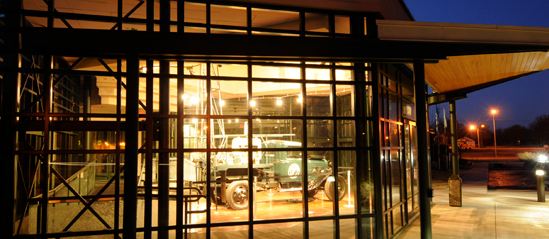
The Cherokee Strip Regional Heritage Center includes a 1927 portable drilling rig created by petroleum technology pioneer George E. Failing, who added a drilling rig to a Ford farm truck. The same engine that drove the sturdy truck across the oilfields was used to power its rotary drill.
Thanks to Ward’s commitment to building the facility, the Cherokee Strip Regional Heritage Center Inc. was created in 2005 through partnerships with the Oklahoma Historical Society (OHS), the Sons & Daughters of the Cherokee Strip Pioneers Association, and the Phillips University Legacy Foundation.
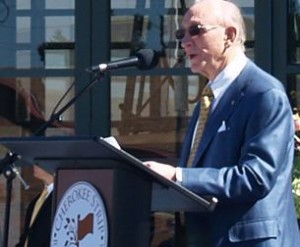
CSHHC Chairman Lew O. Ward (1939-2018) spoke at the 2011 opening. Ward served on the boards of the National Petroleum Council and the College of Engineering at the University of Oklahoma
The former heritage museum at the eastern edge of Enid became a property of the Oklahoma Historical Society in 1976 and is now the Cherokee Strip Regional Heritage Center, including the library.
Ward noted the new center’s oral history library contains more than 260 interviews capturing the stories of the Cherokee Strip from those who have lived them. “This growing library is an invaluable component of historical research for our region,” he added.
“Trained staff and volunteers collect the oral histories of people from the Cherokee Strip and Northwest Oklahoma,” Ward said. “The interviews are then transcribed and made available to the public and for use in the Research Center.”
Further, a the center has hosted teachers seminars on the Enid campus of Northwestern Oklahoma State University, according to Ward. The seminar explained to teaches how to incorporate lessons of leadership into their curriculum through the study of history,” he explained.
In November 2013, the center was selected by the Oklahoma Energy Resources Board (OERB) to partner in the statewide school education programs — OERB Homeroom.
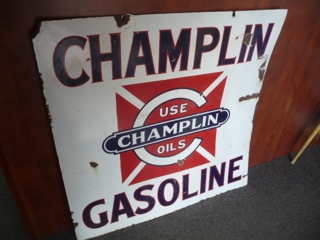
In 1917, Herbert H. Champlin purchased a small refinery on the outskirts of Enid. By 1944 his company operated service stations in 20 states.
OERB spends millions of dollars annually to provide teacher training, curricula and programs that bring the petroleum industry to classrooms across the state — and offers free field trips to selected museums. “We are thrilled that the Heritage Center has been chosen to partner with OERB in their school education program,” said Museum Director Andi Holland in 2011.
“The heritage center’s Dave Donaldson Oil and Gas Gallery is well equipped marking the beginnings of oil and gas production in the Cherokee Strip through its economic importance to Northwestern Oklahoma today,” Holland added. The center’s gallery includes a series of interactive features about how natural resources are found, produced and refined.

A program already created by the heritage center’s education department is called “Boom and Bust, Natural Resources in the Cherokee Strip,” said Cody Jolliff, the Enid museum’s education director.
“This partnership will allow more students to attend the heritage center and learn more about Northwest Oklahoma and the rich natural resources that impact our lives,” Jolliff added.
Cherokee Strip Regional Heritage Center exhibits include: The Outlet – Learn about life before the land run, and how the run changed the course of history; The Land & the People Gallery – Hear the stories of settlers in the years after they staked their claims.
Also among the exhibits, the Thelma Gungoll Phillips University Gallery – Celebrate the founding and history of the first private university in the state.
The Dave Donaldson Oil & Gas Gallery offers a Champlin Oil exhibit. “The Champlin Refining Company, which for many years held the distinction of being the nation’s largest fully integrated oil company under private ownership, was based at Enid,” according to the Oklahoma Historical Society.
The Sooner State’s petroleum industry began one decade before statehood with an 1897 oilfield discovery near a trading post called Bartlesville.
_______________________
Recommended Reading: Oil in Oklahoma (1976); Oil And Gas In Oklahoma: Petroleum Geology In Oklahoma
(1976); Oil And Gas In Oklahoma: Petroleum Geology In Oklahoma (2013); The Oklahoma Petroleum Industry
(2013); The Oklahoma Petroleum Industry (1980). Your Amazon purchase benefits the American Oil & Gas Historical Society. As an Amazon Associate, AOGHS earns a commission from qualifying purchases.
(1980). Your Amazon purchase benefits the American Oil & Gas Historical Society. As an Amazon Associate, AOGHS earns a commission from qualifying purchases.
_______________________
The American Oil & Gas Historical Society preserves U.S. petroleum history. Please become an AOGHS annual supporter today and help maintain this energy education website and expand historical research. For more information, contact bawells@aoghs.org. Copyright © 2025 Bruce A. Wells. All rights reserved.
Citation Information – Article Title: “Cherokee Strip Regional Heritage Center.” Authors: B.A. Wells and K.L. Wells. Website Name: American Oil & Gas Historical Society. URL: https://aoghs.org/cherokee-strip-regional-heritage-center. Last Updated: March 28, 2025. Original Published Date: June 1, 2011.
by Bruce Wells | Feb 3, 2025 | Energy Education Resources
Growing oil demand challenged petroleum geologists, who organized a professional association.
As demand for petroleum grew during World War I, the science for finding oil and natural gas reserves remained obscure when a small group of geologists in 1917 organized what became the American Association of Petroleum Geologists (AAPG).
AAPG began as the Southwestern Association of Petroleum Geologists in Tulsa, Oklahoma, after about 90 geologists gathered at Henry Kendall College, now Tulsa University. They formed an association of earth scientists on February 10, 1917, “to which only reputable and recognized petroleum geologists are admitted.”
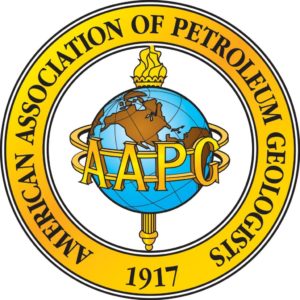
AAPG members maintain a professional business code.
Rapidly multiplying mechanized technologies of the “Great War” brought desperation to finding and producing vast supplies of oil. America entered the First War I two months after AAPG’s founding. An October 1917 giant oilfield discovery at Ranger, Texas, inspired a British War Cabinet member to declare, “The Allied cause floated to victory upon a wave of oil.”
Rock Hounds
In January 1918, the AAPG convention of in Oklahoma City reported 167 active members and 17 associate members. After adopting its present name one year after organizing at Henry Kendall College, the group issued its first technical bulletin, using papers and presentations delivered at the 1917 Tulsa meeting.
The professional “rock hounds” produced a mission statement that included promoting the science of geology, especially relating to oil and natural gas. The geologists also committed to encouraging “technology improvements in the methods of exploring for and exploiting these substances.”
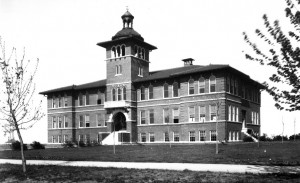
AAPG was founded in Tulsa, Oklahoma, at Henry Kendall College — today’s Tulsa University.
AAPG also began publishing a bimonthly journal that remains among the most respected in the industry. The peer-reviewed Bulletin included papers written by leading geologists of the day.
With a subscription price of five dollars, the journal was distributed to members, university libraries, and other industry professionals.
Finding Faults and Anticlines
By 1920, one petroleum trade magazine — after complaining of the industry’s lack of skilled geologists — noted the “Association Grows in Membership and Influence; Combats the Fakers.”
The article praised AAPG professionalism and warned of “the large number of unscrupulous and inadequately prepared men who are attempting to do geological work.”
Similarly, the Oil Trade Journal praised AAPG for its commitment “to censor the great mass of inadequately prepared and sometimes unscrupulous reports on geological problems, which are wholly misleading to the industry.”

Perhaps the best known such fabrication is related to the men behind the 1930 East Texas oilfield discovery — a report entitled “Geological, Topographical And Petroliferous Survey, Portion of Rusk County, Texas, Made for C.M. Joiner by A.D. Lloyd, Geologist And Petroleum Engineer.”
Using very scientific terminology, A.D. Lloyd’s document described Rusk County geology — its anticlines, faults, and a salt dome — all features associated with substantial oil deposits…and all completely fictitious.
The fabrications nevertheless attracted investors, allowing Joiner and “Doc” Lloyd to drill a well that uncovered a massive oil field, still the largest conventional oil reservoir in the lower-48 states.
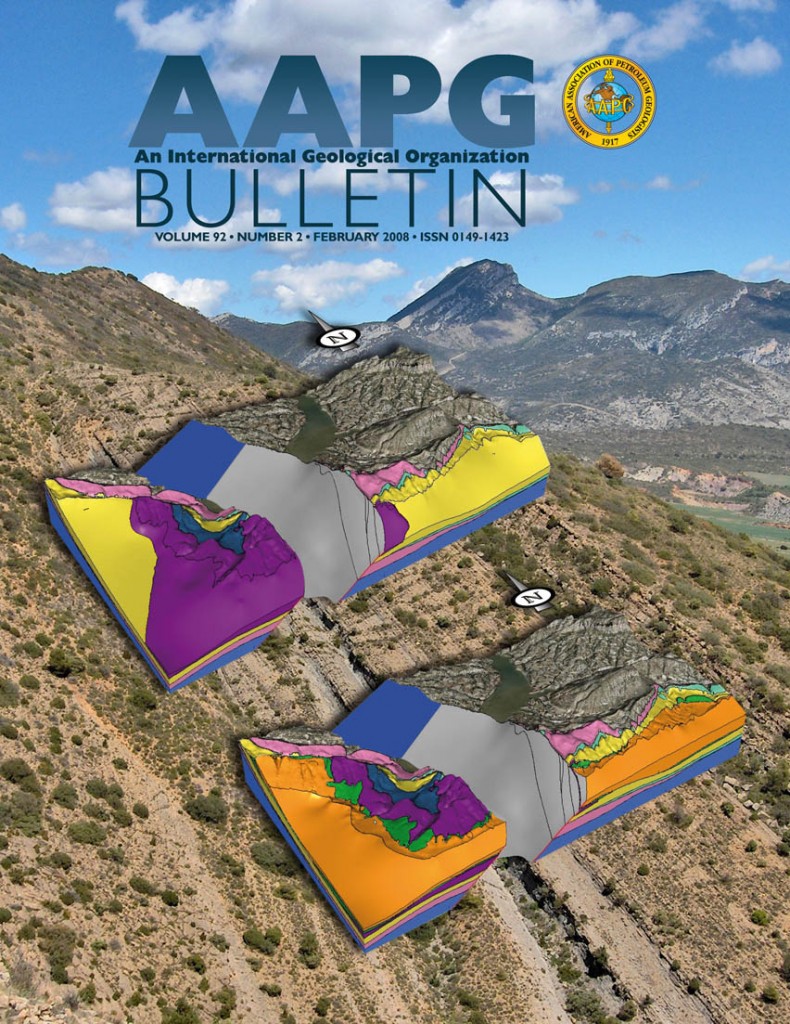
AAPG’s peer-reviewed journal first appeared in 1918, one year after the association’s first meeting in Tulsa.
Equally imaginative science came from Lloyd’s earlier descriptions of the “Yegua and Cook Mountain” formations and the thousands of seismographic registrations he ostensibly recorded. Lloyd, a former patent medicine salesman, and other self-proclaimed geologists, were the antithesis of the AAPG professional ethic.
In 1945, AAPG formed a “Committee on Boy Scout Literature” to assist the Boy Scouts of America in updating requirements for the “mining” badge, which had been awarded since 1911 (learn more in Merit Badge for Geology).

By 1953, AAPG membership had grown to more than 10,000 and a permanent headquarters building opened Tulsa. The association’s 2022 membership included about 40,000 members in 129 countries in the upstream energy industry, “who collaborate — and compete — to provide the means for humankind to thrive.”
The world’s largest professional geological society, a nonprofit organization, maintains a membership code to assure “integrity, business ethics, personal honor, and professional conduct.”
Oil Patch Historians
Longtime AAPG member Ray Sorenson, a Tulsa-based consulting geologist, has made numerous presentations about the history of petroleum. After publishing papers in leading academic journals, he adapted many of his contributions for the association’s 2007 Discovery Series, “First Impressions: Petroleum Geology at the Dawn of the North American Oil Industry.”
Further, Sorenson continued to research and collect a vast amount of material documenting the earliest signs of oil — worldwide references to hydrocarbons earlier that the 1859 first U.S. oil well drilled by Edwin Drake in Pennsylvania.

Drake expert and geologist and historian William Brice, professor emeritus at the University of Pittsburgh at Johnstown, in 2009 published Myth, Legend, Reality – Edwin Laurentine Drake and the Early Oil Industry. His 661-page epic was researched and written as part of the U.S. petroleum industry’s 150th anniversary (learn more in Edwin Drake and his Oil Well),
As part if AAPG’s 2017 centennial events, geologist Robbie Rice Gries published Anomalies: Pioneering Women in Petroleum Geology 1917-2017. Researched with help from AAPG volunteers, her 405-page book includes contributors’ personal stories, written correspondence, and photographs dating back to the early 1900s.
The stories in Gries’ book should be read by every petroleum geologist, geophysicist and petroleum engineer, according to independent producer Marlan Downey, founder of Roxanna Oil Company. “Partly for the pleasure of the sprightly told adventures, partly for a sense of history, and, significantly, because it engenders a proper respect towards all women professionals, forging their unique way in a ‘man’s world.’”
_______________________
Recommended Reading: Anomalies: Pioneering Women in Petroleum Geology 1917-2017 (2017); Trek of the Oil Finders: A History of Exploration for Petroleum (1975); Myth, Legend, Reality – Edwin Laurentine Drake and the Early Oil Industry (2009); The Prize: The Epic Quest for Oil, Money & Power (1991); The Birth of the Oil Industry (1936). Your Amazon purchase benefits the American Oil & Gas Historical Society. As an Amazon Associate, AOGHS earns a commission from qualifying purchases.
(2009); The Prize: The Epic Quest for Oil, Money & Power (1991); The Birth of the Oil Industry (1936). Your Amazon purchase benefits the American Oil & Gas Historical Society. As an Amazon Associate, AOGHS earns a commission from qualifying purchases.
_______________________
The American Oil & Gas Historical Society preserves U.S. petroleum history. Please become an AOGHS annual supporter and help maintain this energy education website and expand historical research. For more information, contact bawells@aoghs.org. Copyright © 2025 Bruce A. Wells. All rights reserved.
Citation Information – Article Title: “AAPG – Geology Pros since 1917.” Authors: B.A. Wells and K.L. Wells. Website Name: American Oil & Gas Historical Society. URL:https://aoghs.org/energy-education-resources/aapg-geology-pros-since-1917. Last Updated: February 4, 2025. Original Published Date: April 29, 2014.
by Bruce Wells | Sep 25, 2024 | Energy Education Resources
A 1928 experimental concrete reservoir for storing Permian Basin oil became a water park in 1958 — for one day.
Tourists traveling I-20 in West Texas should not miss the Monahans oil museum in the heart of the Permian Basin. Not just a collection of artifacts, the Million Barrel Museum’s big attraction is a former experimental oil tank the size of three football fields.
The Permian Basin once was called a “petroleum graveyard” — until a series of oilfield discoveries beginning in 1920 brought exploration companies to the vast, arid region. Completed near Big Lake in 1923, the Santa Rita No. 1 well alone would endow the University of Texas with millions of dollars.
However, as oilfield discoveries grew, the lack of infrastructure for storing and transporting large volumes of oil proved to be a problem. (more…)
by Bruce Wells | Sep 24, 2024 | Energy Education Resources
Western Pennsylvania collection of engines preserves a remarkable history of powering America.
Vintage oilfield engine exhibits are part of an unusual Pennsylvania museum in the rustic hills of Pennsylvania near Little Sandy Creek, just off Colonel Drake Highway 36, about 10 miles northwest of Punxsutawney.
Indoor and outdoor displays of rare engines, many carefully restored and maintained by volunteers, educate visitors about the 19th-century evolution of internal combustion technologies that helped end the age of steam.
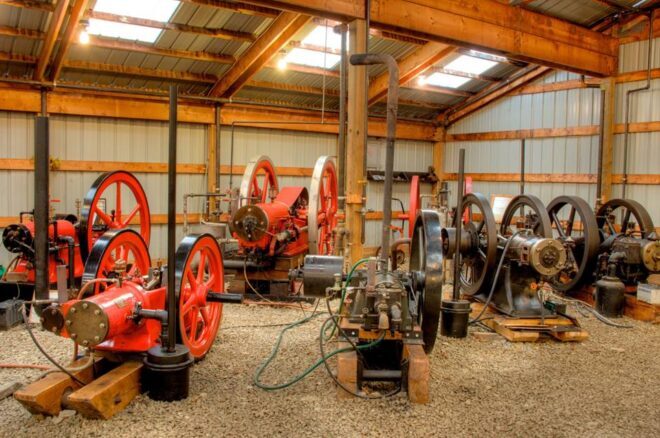
The Coolspring Power Museum opened in 1985 near Punxsutawney, Pennsylvania. It has the largest collection of historically significant stationary gas engines in the country, if not the world. Photo courtesy Coolspring Power Museum.
The Cool Spring Power Museum, which opened in 1985, exists thanks to its long-time director who spent decades collecting and preserving hundreds of engines of all shapes and sizes. In a 2004 interview, Dr. Paul E. Harvey explained why the collection was important.

“Internal combustion engines revolutionized the world around the turn of the 20th century in much the same way that steam engines did a century before,” noted Dr. Harvey, who co-founded the museum in 1985 about midway between Punxsutawney and Brookville, Pennsylvania.
“One has only to imagine a coal-fired, steam-powered, airplane to realize how important internal combustion was to the industrialized world,” added Dr. Harvey, a medical doctor.
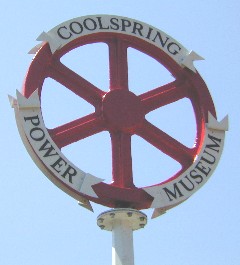
The museum hosts many summer events, including a “History Day and Car, Truck & Tractor Show.” Photo by Bruce Wells.
According to Dr. Harvey, permanent exhibits at Coolspring include stationary gas “hit and miss” engines, throttle-governed engines, flame ignition engines, hot tube ignition engines, and hot air engines ranging in size from a fractional horsepower up to 600 horsepower.
Many engine enthusiasts from around the country have sent significant pieces for display, he said. The grounds, as well as semi-annual shows, have expanded with visitors from Maine to California, as well as Canada and England.
Dr. Harvey explained that early internal combustion engines produced only a few horsepower and could not replace steam engines in most applications, but by 1890 they were powerful enough for most portable or remote operations as well as many small manufacturers.

By 1900 the new power technology was replacing reciprocating steam engines for electric generation, Dr. Harvey noted. “By 1915 they were being considered for all but the largest installations where steam turbines have since dominated,” he added. Dr. Harvey and fellow enthusiast John Wilcox began collecting engines in the 1950s. Their collections were the basis of displays that would greatly multiply.
The museum is housed in 20 buildings that, besides its own large collection, contain many pieces placed there on loan. Dr. Harvey said the purpose of Coolspring was “to be the foremost collection of early internal combustion technology presented in an educational and visitor-oriented manner and to provide an operation that will gain support and generate substantial growth.”
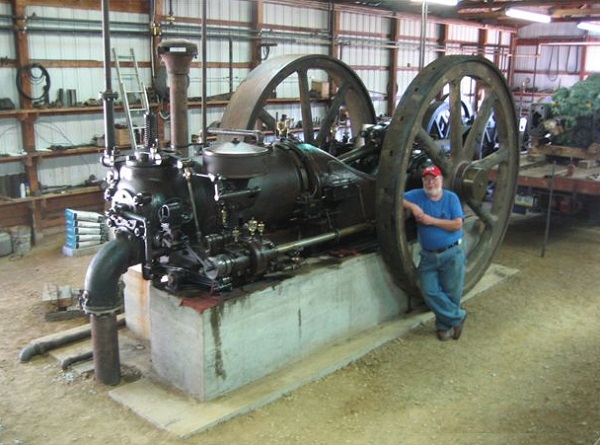
Dr. Paul Harvey, co-founder of the Coolspring Power Museum in Pennsylvania, next to a 175 HP Otto engine he restored with help of museum volunteers. Photo courtesy the Coolspring Power Museum.
The collection documents the early history of the internal combustion revolution. Almost all of the critical components of today’s engines have their origins in the period represented by the collection (as well as hundreds of innovations no longer used). Some of the engines represent real engineering progress; others are more the product of inventive minds avoiding previous patents. All tell a story.
Although the museum’s focus is on stationary engines (with perhaps the largest collection anywhere), Dr. Harvey explained that no museum of internal combustion engines would be complete without at least a few vehicles in its collection. Among the antique heavy trucks and semis, is a rare petroleum well service rig.
The Hanley & Bird Well Bailing Machine was designed to clean a well by lifting water, sand, and debris from the bottom of the well using a “bailer” attached to a cable, noted the museum director.
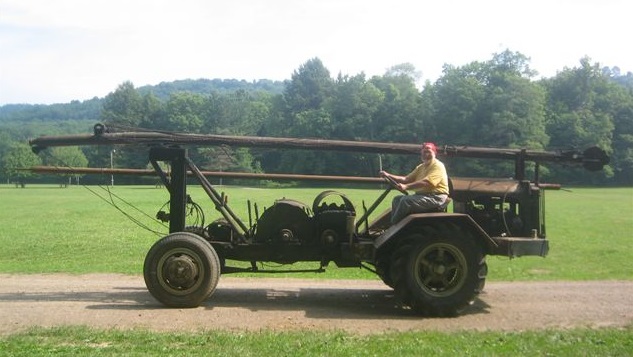
A “last of its kind” Hanley & Bird Well Bailing Machine from the Pennsylvania oilfields. Photo courtesy Coolspring Power Museum.
Five of the devices were built; the Coolspring Power Museum’s example is the only one to survive. “It was donated to the museum by EXCO Resources, the successor to H&B,” Dr. Harvey said. “It is very interesting as it uses a chain drive Mack rear end and a Ford front axle.”
Dr. Harvey recalled seeing the Hanley & Bird Well Bailing Machine driving through Coolspring on its way to service local natural gas wells. He said that the museum today displays it with the mast raised and ready to work. “It certainly shows the ingenuity of the local gas industry,” he reported.
The Coolspring Power Museum collection includes many engines used to power multiple wells in America’s first oilfields. The museum is off Route 36 midway between Punxsutawney and Brookville in western Pennsylvania.

As the steam engines revolutionized the world in the 1800s, the internal combustion engines on exhibit at the Coolspring Power Museum did the same at the start of the 20th century, according to Dr. Harvey.
“You have only to imagine a coal-fired, steam-powered, airplane to realize how important internal combustion was to the industrialized world,” the doctor added with a chuckle.
The Coolspring Power Museum hosts events in the spring and summer, including the History Day and Car, Truck & Tractor Show. The 2024 Spring Exposition included the museum bringing back its popular late 19th-century Foos Gas Engine Company gasoline engine (with timed fuel injection rather than a carburetor) and noting, “Foos was a very successful engine builder of a variety of types and sizes of efficient engines.”
_______________________
Recommended Reading: Around Titusville, Pa., Images of America (2004); Myth, Legend, Reality: Edwin Laurentine Drake and the Early Oil Industry
(2004); Myth, Legend, Reality: Edwin Laurentine Drake and the Early Oil Industry (2009); Oil on the Brain: Petroleum’s Long, Strange Trip to Your Tank
(2009); Oil on the Brain: Petroleum’s Long, Strange Trip to Your Tank (2008); A History of the New York International Auto Show: 1900-2000
(2008); A History of the New York International Auto Show: 1900-2000 (2000). Your Amazon purchase benefits the American Oil & Gas Historical Society. As an Amazon Associate, AOGHS earns a commission from qualifying purchases.
(2000). Your Amazon purchase benefits the American Oil & Gas Historical Society. As an Amazon Associate, AOGHS earns a commission from qualifying purchases.
_______________________
The American Oil & Gas Historical Society (AOGHS) preserves U.S. petroleum history. Please become an AOGHS annual supporter and help maintain this website and expand historical research. For more information, contact bawells@aoghs.org. Copyright © 2024 Bruce A. Wells. All rights reserved.
Citation Information: Article Title: “Cool Coolspring Power Museum.” Authors: B.A. Wells and K.L. Wells. Website Name: American Oil & Gas Historical Society. URL: https://aoghs.org/energy-education-resources/cool-coolspring-power-museum. Last Updated: September 30, 2024. Original Published Date: September 1, 2005.
.
by Bruce Wells | Aug 8, 2024 | Energy Education Resources
A 1991 Oklahoma oil discovery in a hidden meteor crater attracted worldwide attention.
About 450 million years ago, a meteor about the size of a football struck north-central Oklahoma, creating an impact crater — an astrobleme — more than eight miles wide.
The small town of Ames (population 183 at the 2020 census) proudly claims the crater as its own – and as a significant contributor to the geological knowledge of the nation’s petroleum industry.
(more…)
by Bruce Wells | Aug 1, 2024 | Energy Education Resources
Central Texas oil museum preserves the discovery — and folklore — of a giant 1920s oilfield.
In a restored 1885 mercantile building downtown, the Luling Oil Museum (also known as the Central Texas Oil Patch Museum) exhibits historic drilling and production equipment from the Luling oilfield of the 1920s. While educating students about the modern petroleum industry, the museum gives little credence to the once widely told tale of Luling’s giant field being discovered thanks to a “reading” by a famous psychic.
Known for its tasty BBQ ribs, watermelon seed-spitting contest, and colorfully decorated oil pump jacks, Luling became part of U.S. petroleum history when leading citizen Edgar B. Davis discovered oil there in 1922.
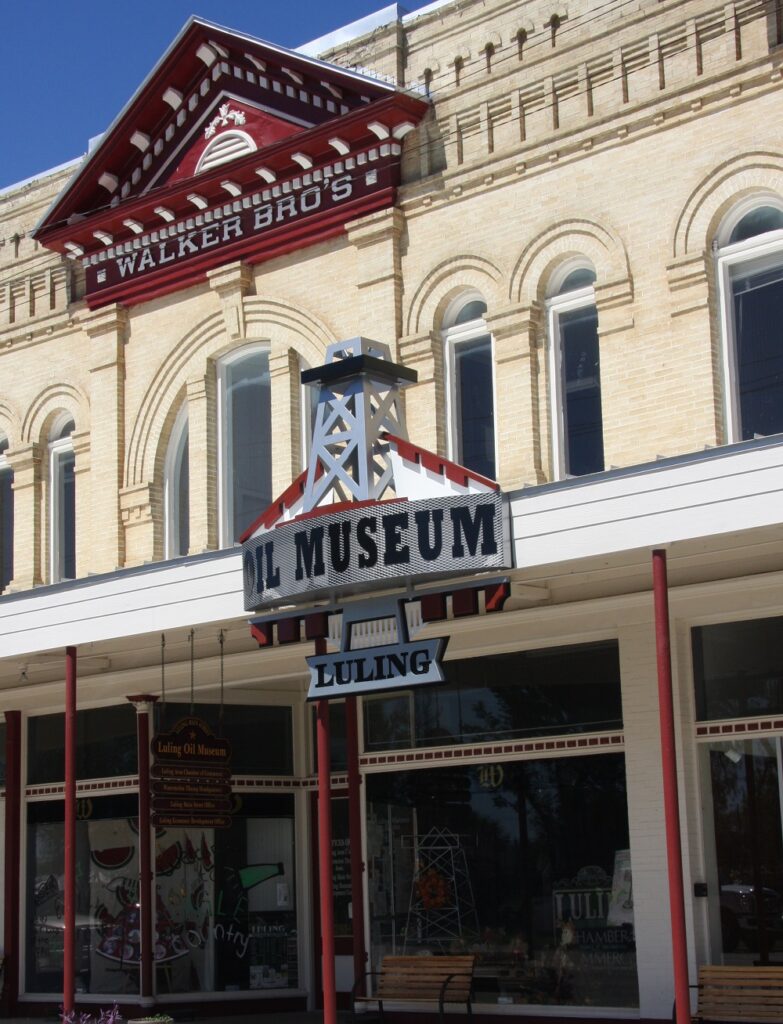
Exhibits in Luling’s restored 1885 mercantile store educate visitors about 1920s oil discoveries and their role in the Texas petroleum industry. Photo courtesy Luling Oil Museum.
Luling’s oilfield discovery northeast of San Antonio and south of Austin allowed the small town to join recent oil booms already making headlines to the north in Ranger (1917) and Burkburnett (1918). At its peak in 1924, the Luling field had about 400 wells producing more than 11 million barrels of oil.

Years later, new technologies like horizontal drilling helped reinvigorate the central Texas oil patch, according to Carol Voight, a director of the Luling Oil Museum interviewed by an Austin TV news reporter in 2013.

The city of Luling, Texas, has hosted a watermelon festival every June since 1954.
The oil museum, “shows the contrast of the tools and technology of the past with those utilized in the oil industry today,” Voight explained. Exhibits trace the development of the oil industry — from the first U.S. oil well in 1859 in Pennsylvania to the social and economic impact on central Texas.
Housed in the 1885 Walker Brothers mercantile store and renovated several times, the Luling Oil Museum building once sold “everything from nails and hammers to ladies shoes, to toys,” reported the Lockhart Post-Register in a 2021 article about the renovation. “It was the oldest continually operating mercantile store in Texas until it closed in 1984.”
After its founding in 1990, the Luling Oil Museum purchased the building four years later to showcase what made Luling one of the toughest boom towns in Texas. The historic building’s most recent renovation, which incorporated new heating, ventilation, and air conditioning powered by geothermal wells, has provided new exhibit spaces.
“We strive to demonstrate the struggles between the men and women who were the oilfield pioneers and to create a better understanding of the process of oil exploration and production,” noted one volunteer.
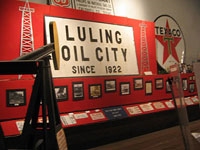
Edgar B. Davis in 1922 discovered an oilfield 12 miles long. Photo by Bruce Wells.
“Our collection includes a working model of a modern oil rig, pump jacks, the ‘Oil Tank Theater,’ and an excellent assortment of tools from each decade of the oil industry,” added Voight. To preserve the city’s petroleum heritage, locally donated artifacts show “not only how it was in the olden days,” but also “what can be accomplished with community efforts, cooperation, and creative programs.”
Museum staff in 2015 credited Luling area petroleum companies and service companies like Tracy Perryman, himself a multi-generation independent producer. One of the museum’s great outreach success stories was “Reflections of Texas Art Exhibit.”

Combined with the permanent oil exhibits, the art show attracted more school field trips from San Antonio. Another program was an annual quilt show, which brought another kind of audience into the museum’s oil exhibit spaces. Like many small oil and gas museums, preservation work depends on community support.
In a frugal approach to integrating downtown with outdoor exhibit space, the museum in 2012 partnered with Susan Rodiek, PhD, and graduate students of architectural design at Texas A&M University. Her student teams proposed designs to economically exploit existing facilities while providing new exhibit spaces. Students approached the project competitively, proclaiming the museum their “first client.”
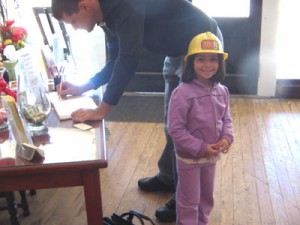
Dad signs the museum guestbook for this visitor. Photo by Bruce Wells.
Museum Association Board Member Trey Bailey noted, “The preliminary designs that the Aggie students presented to us were fantastic. There were some terrific concepts and the work was detailed and quite fascinating.”
Voight added, “They really got it – Luling’s rich heritage in oil, the E.B. Davis story and more. Being able to get this quality of work and vision is tremendous to our efforts to showcase some of the true historic gems of Luling. “Dr. Rodiek and her able team have again offered us the ability to get this project moving, especially considering the limited budget we have at this time.”
Once known as the toughest town in Texas, visitors today flock to Luling on the first Saturday in April for the annual Roughneck BBQ and Chili Cook-Off. — where they have found “Best ribs in the country,” according to Reader’s Digest. Crowds also gather every June for the renowned Watermelon Thump Festival and Seed-Spitting Contest.
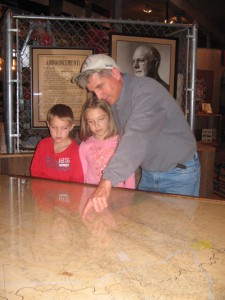
Museum Association Board Member Trey Bailey and his children examine a map of the 1920s Luling oilfield. Photo by Bruce Wells.
The Guinness Book of World Records has documented Luling’s watermelon seed-spitting with a distance of 68 feet, 9 and 1/8 inches, set in 1989. The distance reportedly is still unbeaten.
Learn petroleum history at the Luling Oil Museum.
Discovering the Luling Oilfield
Although the Luling Oil Museum’s historic Walker Brothers building was a center for trading cotton, crude oil replaced cotton in Luling’s future thanks to Edgar B. Davis and his Rafael Rios No. 1 discovery well of August 9, 1922.

After drilling six consecutive dry holes near Luling, Davis’ heavily in debt United North & South Oil Company finally struck “black gold.” The wildcat well revealed an oilfield that proved to be 12 miles long and two miles wide.
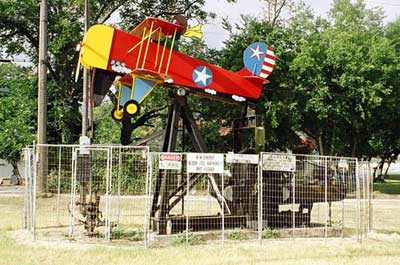
After sampling “the best ribs in the country,” visitors to Luling, Texas, marvel at the many decorated pump jacks seen in its historic downtown.
Some people proclaimed that Davis, president of the exploration company, found the town’s oil-rich geologic formation after getting a psychic reading from clairvoyant Edgar Cayce. A geologist working for Davis figured out the oilfield’s likely location.
“Many have called Edgar B. Davis eccentric, and perhaps it was his unconventional personality that led to several half-truths about a career that would be exceptional without embellishment,” noted Riley Froh in a 1979 article in the East Texas Historical Journal.
In the early summer of 1922, Davis was struggling financially when he located the oilfield’s discovery well five miles northwest of Luling. “Drilling on the recommendation of only one geologist and against the advice of several, Davis located his seventh well at random,” Froh reported.
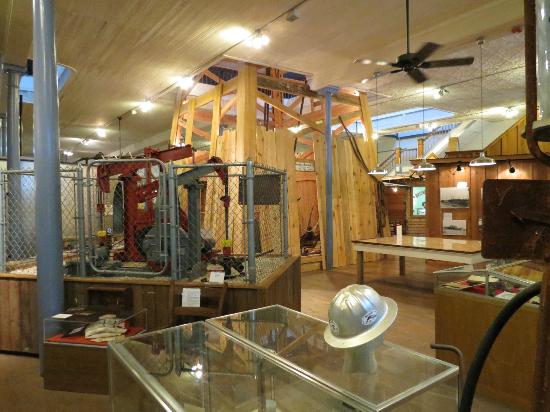
Luling’s downtown museum preserves “the vibrant life and times of the ‘the toughest town in Texas’ and the oil boom in the Central Texas oil patch.” Photo courtesy Luling Oil Museum.
By 1924, Luling was a top-producing oilfield in the United States, exceeding the early 1900s fields of southeastern Texas, including Sour Lake and even the world-famous Spindletop Hill.
Exhibits at the Luling Oil Museum focus on the real science behind the discovery, which resulted in the town’s population skyrocketing from less than 500 people to 5,000 people within months after the Rafael Rios No. 1 well.
Psychic Dreams of Oil
Biographers of the once famous American psychic Edgar Cayce have noted that he found his own mysterious path into exploring the oil patch at Luling. In 1904, Cayce was a 27-year-old photographer when a local newspaper described his “wonderful power that is greatly puzzling physicians and scientific men.”
The Hopkinsville Kentuckian reported that Cayce – from a hypnotic state – could seemingly determine causes of ailments in patients he never met. By 1910, the New York Times proclaimed that “the medical fraternity of the whole country is taking a lively interest in the strange power possessed by Edgar Cayce to diagnose difficult diseases while in a semi-conscious state.”

As his reputation grew, Cayce expanded his photography business with the addition of adjacent rooms and a specially made couch so he could recline to render readings. He became known as “The Sleeping Prophet” while his readings expanded beyond medical diagnoses into reincarnation, dream interpretation, psychic phenomenon…and advising oilmen.
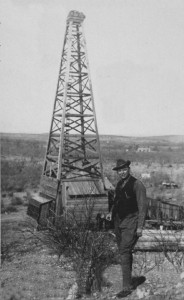
Edgar Cayce visited his drilling site in San Saba County, Texas, in 1921. The once-famous psychic’s abilities failed him searching for oil.
Sidney Kirkpatrick, author of Edgar Cayce: An American Prophet , explained that Cayce in 1919 provided detailed trance revelations to several oilmen probing the prolific Desdemona oilfield in Eastland County, Texas. The results reportedly inspired Cayce and several partners to form their own company.
, explained that Cayce in 1919 provided detailed trance revelations to several oilmen probing the prolific Desdemona oilfield in Eastland County, Texas. The results reportedly inspired Cayce and several partners to form their own company.
In September 1920, Cayce became the clairvoyant partner of Cayce Petroleum Company. Guided by his own psychic readings, Cayce Petroleum Company leased some acreage around Luling. Not far away, Edgar B. Davis had drilled eight dry holes and nearly went broke before completing the discovery well for Luling’s oilfield.
But raising capital for Cayce Petroleum drilling proved difficult and eventually led to loss of the Luling leases. Cayce’s company tried again 150 miles north in San Saba County, Texas, and according to Kirkpatrick’s book, Cayce’s readings included “detailed descriptions given of the various rock geological formations that would be encountered as they drilled.”
Cayce Petroleum’s Rocky Pasture No. 1 well would drill beyond 1,650 feet in search of what Cayce described as a “Mother Pool,” capable of producing 40,000 barrels of oil a day. The psychic’s exploration company did not find any oil, ran out of money, and failed.
Salt Dome Faults
In a 2017 email to the American Oil & Gas Historical Society, long-time AOGHS member Dan Plazak noted Cayce spoke of finding oil at a salt dome at Luling. Petroleum and the geology of salt domes had been in the news since one had been revealed at Spindletop Hill in 1901, thanks to the persistence of Patillo Higgins, “Prophet of Spindletop.”

Plazak, a consulting geologist and engineer, reported that Cayce, “speaking in a trance, proclaimed that oil would be found at Luling associated with a salt dome. But there are no salt domes at Luling, and Cayce’s bad psychic advice could only have prevented Davis from finding oil.
“It was a geologist working for Davis who saw faulting in the outcrop, and correctly predicted that the oil would be trapped behind the fault,” Plazak added.
An associate of Cayce, David Kahn, later wrote Davis asking the successful oilman to give some of the Luling profits to Cayce, but Davis declined. “Edgar Davis was famously generous, but his refusal to reward Cayce indicates that he didn’t consider Cayce to have been of much help,” explained Plazak in an email to AOGHS.
However, the geologist added, Davis continued to consult Cayce concerning possible presidential ambitions — Davis had convinced himself he was destined for the White House.
Plazak explained that it was a geologist working for Davis who saw faulting in the outcrop, and correctly predicted that the oil would be trapped behind the fault.
After a few early wells, “Cayce’s oil-exploration readings were a complete bust, both for his own oil company and later for many other oil drillers, in locations all over the country.”
In his email, Plazak — a “geologist and researcher of finding oil with doodlebugs, dreams, and crystal balls” from Colorado — added there are still those today who believe in psychic advice who no doubt are “raising money on the internet to drill yet another dry hole in San Saba County.”
Despite the psychic’s exploration readings not working, investors apparently can still be tempted with promotions of Cayce’s ability to find a “mother pool of oil.” More interesting research from oil patch detective Dan Plazak can be found at Mining Swindles.

A graduate of Michigan Tech and the Colorado School of Mining, Plazak in 2010 wrote “an entertaining and informative volume that delightfully investigates the history of mining frauds in the United States from the Civil War to World War I,” according to his publisher, the University of Utah Press.
“In his estimable work, A Hole in the Ground with a Liar at the Top, Dan Plazak strikes it rich with his examination of the old west’s most successful villains and their crimes.” — Utah Historical Quarterly
Modern “Crudoleum”
Today, the psychic legacy of failed oilman Edgar Cayce lives on at the Association for Research and Enlightenment in Virginia Beach, Virginia, founded in 1931, and “the official world headquarters of the works of Edgar Cayce, considered America’s most documented psychic.”

A psychic’s petroleum product sold today.
An invention from Cayce’s venture into the oil business remains on the market — his “pure crude oil” product he recommended as a first step toward replenishing healthy hair. Cayce invented a “pure crude oil” product he called Crudoleum, which is sold today as a cream, shampoo and conditioner. Baar Products Inc. of Downingtown, Pennsylvania, offers Crudoleum Pennsylvania Crude Oil Scalp Treatment.
_______________________
Recommended Reading: Texas Art and a Wildcatter’s Dream: Edgar B. Davis and the San Antonio Art League (1998); Drilling Technology in Nontechnical Language
(1998); Drilling Technology in Nontechnical Language (2012); Edgar Cayce: An American Prophet
(2012); Edgar Cayce: An American Prophet (2001); A Hole in the Ground with a Liar at the Top: Fraud and Deceit in the Golden Age of American Mining (2010). Your Amazon purchase benefits the American Oil & Gas Historical Society. As an Amazon Associate, AOGHS earns a commission from qualifying purchases.
(2001); A Hole in the Ground with a Liar at the Top: Fraud and Deceit in the Golden Age of American Mining (2010). Your Amazon purchase benefits the American Oil & Gas Historical Society. As an Amazon Associate, AOGHS earns a commission from qualifying purchases.
Learn more U.S. petroleum history by visiting the Luling Oil Museum in the historic Walker Brothers building in downtown Luling.
_______________________
The American Oil & Gas Historical Society (AOGHS) preserves U.S. petroleum history. Please become an AOGHS annual supporter and help maintain this energy education website and expand historical research. For more information, contact bawells@aoghs.org. © 2024 Bruce A. Wells.
Citation Information – Article Title: “Central Texas Oil Patch Museum.” Authors: B.A. Wells and K.L. Wells. Website Name: American Oil & Gas Historical Society. URL: https://aoghs.org/energy-education-resources/luling-oil-field. Last Updated: August 1, 2024. Original Published Date: June 21, 2015.




(1976); Oil And Gas In Oklahoma: Petroleum Geology In Oklahoma
(2013); The Oklahoma Petroleum Industry
(1980). Your Amazon purchase benefits the American Oil & Gas Historical Society. As an Amazon Associate, AOGHS earns a commission from qualifying purchases.



















